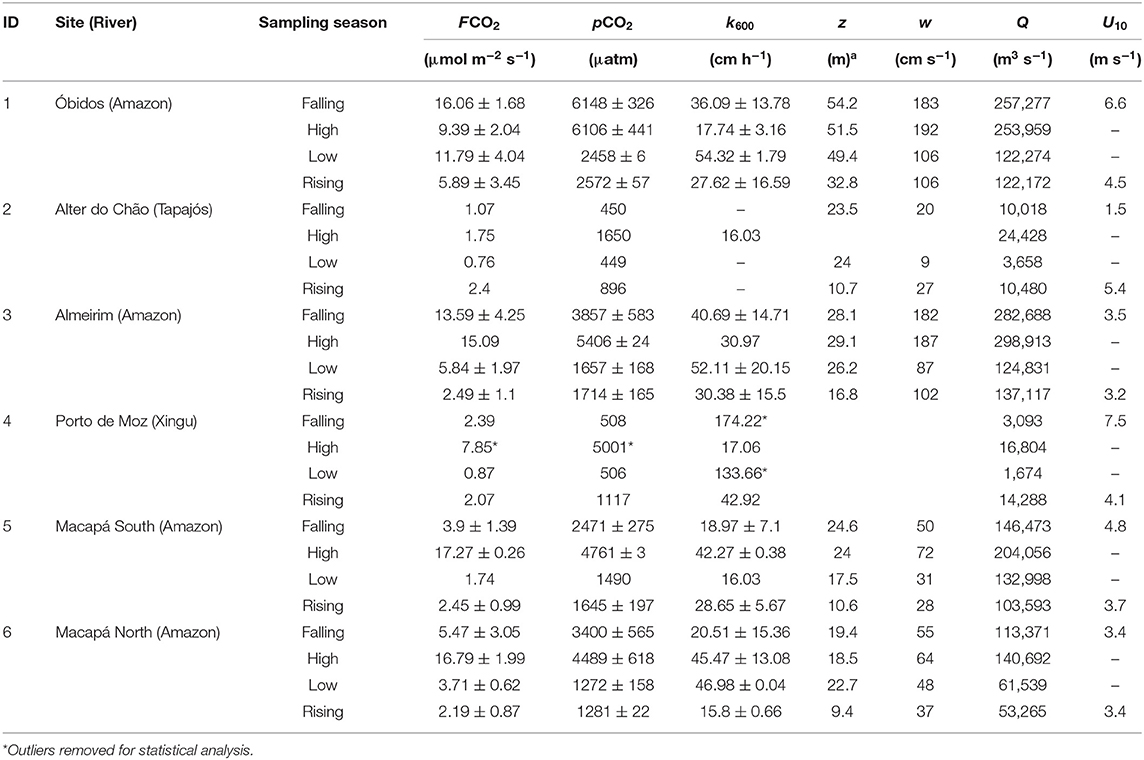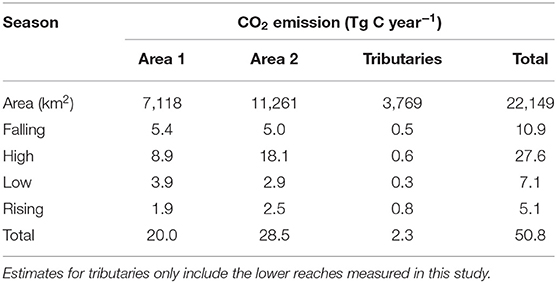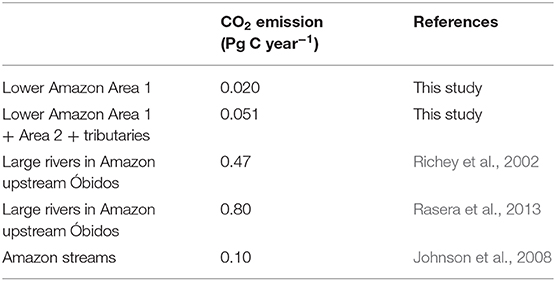- 1Centro de Energia Nuclear na Agricultura, Universidade de São Paulo, Piracicaba, Brazil
- 2School of Oceanography, University of Washington, Seattle, WA, United States
- 3Instituto Sócio Ambiental e dos Recursos Hídricos, Universidade Federal Rural da Amazônia, Belém, Brazil
- 4Whitney Laboratory for Marine Bioscience, University of Florida, St. Augustine, FL, United States
- 5Marine Sciences Laboratory, Pacific Northwest National Laboratory, Sequim, WA, United States
- 6Departamento de Sensoriamento Remoto, Instituto Nacional de Pesquisas Espaciais, São José dos Campos, Brazil
- 7Departamento de Meio Ambiente e Desenvolvimento, Universidade Federal do Amapá, Macapá, Brazil
A Corrigendum on
Carbon Dioxide Emissions along the Lower Amazon River
by Sawakuchi, H. O., Neu, V., Ward, N. D., Barros, M. d. L. C., Valerio, A. M., Gagne-Maynard, W., et al. (2017). Front. Mar. Sci. 4:76. doi: 10.3389/fmars.2017.00076
In the original article, there was an error in the upscaling of site-specific flux rates to local emissions for the different areas considered in the paper for the lower Amazon River. Hence, the error propagated throughout our local and global estimates presented in different sections of the paper and Tables 3, 4. Minor mistakes were also in the discharge values for lower and rising sampling season for IDs 5 (South Macapá) and 6 (North Macapá), which are switched in Table 1 and the values of Areas 1 and 2 presented in the Methods.

Table 1. CO2 fluxes to atmosphere (FCO2), partial pressure of CO2 in the water (pCO2), gas transfer velocity (k600) measurements according to site and season (mean ± SD) and measurements of mean depth (z), water velocity (w), discharge (Q) and wind speed (U10).
Several corrections have been made to the text of the article and the updated sections are as follows:
Abstract: “We estimate that the lower Amazon River mainstem emits 20 Tg C year−1 within our study boundaries, or as much as 48 Tg C year−1 if the entire spatial extent to the geographical mouth is considered. Emissions from the Xingu and Tapajós lower tributaries contribute an additional 2.3 Tg C year−1. Including these values with updated basin scale estimates and estimates of CO2 outgassing from small streams we estimate that the Amazon running waters outgasses as much as 0.95 Pg C year−1, increasing the global emissions from inland waters by 15% for a total of 2.45 Pg C year−1. These results highlight the lower reaches of large rivers as a missing gap in basin-scale and global carbon budgets. In the case of the Amazon River, the previously unstudied tidally-influenced reaches contribute to 5% of CO2 emissions from the entire basin.”
Methods section, subsection Annual CO2 Emissions from the Lower Amazon River, the first paragraph:
“We divided the main channel into two zones: (Area 1) our study boundaries from Óbidos to Macapá, which has a surface area of 7,118 km2, and (Area 2) the region extending from Macapá to the geographical river mouth, which has an additional surface area of 11,261 km2 (Figure 1).”
Results section, subsection Upscaling CO2 Emissions from the Lower Amazon River:
“The total flux of CO2 from the main channel of the lower Amazon River was calculated for two zones (Figure 1) for each 3-month hydrologic period and annually (Table 3). The most conservative estimates (Area 1) only included the boundaries of this study, from Óbidos to Macapá, which had an average wetted surface area of 7,118 km2. The flux of CO2 from Area 1 was 20 Tg C year−1. Area 2 extends from Macapá to the region of the mouth where the connection to land terminates, which had an additional surface area of 11,261 km2. Area 2 had a total CO2 flux of 28 Tg C year−1, based on an extrapolation of average values measured across the north and south Macapá channels (Table 3). The sum of fluxes for these two zones, or the total emissions from Óbidos to the actual river mouth was 48 Tg C year−1. The emissions from the lower Tapajós and Xingu rivers were 1.40 and 0.86 Tg C year−1, respectively. Including these two tributaries to the budget would add more 2.26 Tg C year−1.”
Discussion section, the eighth paragraph:
“Here we considered two different areas for upscaling annual CO2 emissions from the lower Amazon River. Our most conservative estimate, including the area from Óbidos to Macapá (Area 1), was 20 Tg C year−1. Area 2, which extends to the geographic terminus of the river, is a relatively short distance compared to Area 1, but covers 58% more surface area than the Óbidos to Macapá reach (Table 3). Applying the average FCO2 observed near Macapá, we estimate Area 2 to emit 28 Tg C year−1, which combined with the upstream section totalize 48 Tg C year−1. Emissions from the Xingu and Tapajós tributaries contribute an additional 2.3 Tg C year−1, resulting in a total flux of 51 Tg C year−1 from the lower Amazon River basin. This estimate for the lower Amazon River, alone, is roughly 53% in magnitude compared to CO2 emissions from all rivers in the conterminous United States (97 Tg C year−1; Butman and Raymond, 2011) and ~12% of past estimates of basin-scale emissions from the Amazon (0.47 Pg C year−1; Richey et al., 2002).”
Discussion section, the ninth paragraph:
“Adding our estimations of the fluxes estimated for Area 1 and the sum of Area 1 and 2 to estimations by Richey et al. (2002) increases basin-scale CO2 outgassing to 0.49 and 0.52 Pg C year−1, respectively. A recent re-evaluation of basin-wide outgassing estimates upstream of Óbidos was done using a combination of direct flux measurements and more detailed k-values calculations along with observations by Alin et al. (2011) for tributaries and streams. It was estimated that basin scale CO2 outgassing upstream from Óbidos was roughly 0.8 Pg C year−1 (Rasera et al., 2013). First order streams add an additional 0.1 Pg C year−1 to basin scale CO2 fluxes in the Amazon basin (Johnson et al., 2008). Adding our estimates for the lower river to these values results in basin-wide budgets of 0.92 Pg C year−1 and 0.95 Pg C year−1 for Area 1 and the sum of Area 1 and 2, respectively (Table 4). Replacing these new estimates for the Amazon in the global CO2 budget by Raymond et al. (2013) increases the global budget by as much as 18% for a total of 2.48 Pg C year−1.”
Discussion section, the tenth paragraph:
“In the case of this updated global budget, the Amazon River represents 38% of global CO2 emissions. However, the contribution of other tropical rivers to the global budget are likely also underestimated considering that most tropical rivers are even less well-characterized than the Amazon, particularly in the lower reaches, where we've demonstrated that emissions can be high relative to the rest of the basin. Furthermore, we have not included the entirety of the Amazon in our newest budgets. For example, the Tapajós and Xingu rivers were not included due to their large spatial expanse and minimal data coverage. The lower portion of these tributaries, alone (Figure 1), emit roughly 2.3 Tg C year−1, and these estimates do not encompass their entire surface area nor potentially elevated CO2 concentrations closer to their headwaters.”
Discussion section, the eleventh paragraph:
“Another factor that can lead to an underestimation of basin-wide budgets is not including Amazon River water that travels further offshore from Area 2 and along the coastline. For example, the Amazon River can remain unmixed with the ocean as far as 60 km offshore from Area 2 (Molinas et al., 2014). Abril et al. (2014) estimated that only 18% of the CO2 from a point source would be degassed in a stretch of approximately 150 km downstream in the Amazon River taking into account a k-value of 15 cm h−1 and water current of 150 cm s−1. Thus, it is reasonable to assume that the mouth of the Amazon is the last point source of CO2 to the Amazon plume, sustaining significant emissions for a significant distance offshore. This region, along with near-shore coastal waters, is not included in any studies of CO2 cycling in the Amazon River plume in the Atlantic Ocean due to a lack of sampling and terrestrial contamination of remote sensing products by adjacency effect near-shore (Cooley et al., 2007; Subramaniam et al., 2008). We estimate that Area 3 may emit up to an additional 31 Tg C year−1, but note that this is a simple calculation based on measurements at Macapá. Further exploration of this offshore area is essential for constraining the total basin-wide CO2 flux. Although it is too early to confidently incorporate this offshore freshwater region (Area 3) into basin-wide budgets, this rough estimation highlights that expansive regions of offshore freshwater plumes may be an important missing gap in aquatic carbon budgets.”
Concluding Remarks section, the first paragraph, the third sentence:
“Here we show that the lower reaches of the Amazon River are an active area in terms of freshwater CO2 emissions from the Amazon, and perhaps the world, although, lower river reaches have yet to be adequately studied in other comparable tropical systems.”
Concluding Remarks section, the second paragraph, the first and second sentences:
“The enormous surface area of the lower Amazon River (18,379 km2) is slightly less than half of the area of rivers and stream in the conterminous United States (Butman and Raymond, 2011), and similarly emits roughly half as much CO2 to the atmosphere. This area alone releases an amount of CO2 in the same order of magnitude than the uptake by the Amazon River plume in the Atlantic Ocean (Kortzinger, 2003; Cooley et al., 2007; Subramaniam et al., 2008).”
The authors apologize for these errors and state that they do not change the scientific conclusions of the article in any way. The original article has been updated.
References
Abril, G., Martinez, J. M., Artigas, L. F., Moreira-Turcq, P., Benedetti, M. F., Vidal, L., et al. (2014). Amazon River carbon dioxide outgassing fuelled by wetlands. Nature 505, 395–398. doi: 10.1038/nature12797
Alin, S. R., Rasera, M. F. F. L., Salimon, C. I., Richey, J. E., Holtgrieve, G. W., Krusche, A. V., et al. (2011). Physical controls on carbon dioxide transfer velocity and flux in low-gradient river systems and implications for regional carbon budgets. J. Geophys. Res. Biogeosci. 116:G01009. doi: 10.1029/2010jg001398
Butman, D., and Raymond, P. A. (2011). Significant efflux of carbon dioxide from streams and rivers in the United States. Nat. Geosci. 4, 839–842. doi: 10.1038/ngeo1294
Cooley, S. R., Coles, V. J., Subramaniam, A., and Yager, P. L. (2007). Seasonal variations in the Amazon plume-related atmospheric carbon sink. Glob. Biogeochem. Cycles 21:GB3014. doi: 10.1029/2006gb002831
Johnson, M. S., Lehmann, J., Riha, S. J., Krusche, A. V., Richey, J. E., Ometto, J., et al. (2008). CO2 efflux from Amazonian headwater streams represents a significant fate for deep soil respiration. Geophys. Res. Lett. 35:L17401. doi: 10.1029/2008gl034619
Kortzinger, A. (2003). A significant CO2 sink in the tropical Atlantic Ocean associated with the Amazon River plume. Geophys. Res. Lett. 30:2287. doi: 10.1029/2003gl018841
Molinas, E., Vinzon, S. B., Vilela, C. D. X., and Gallo, M. N. (2014). Structure and position of the bottom salinity front in the Amazon Estuary. Ocean Dynamics 64, 1583–1599. doi: 10.1007/s10236-014-0763-0
Rasera, M. F. F. L., Krusche, A. V., Richey, J. E., Ballester, M. V. R., and Victória, R. L. (2013). Spatial and temporal variability of pCO2 and CO2 efflux in seven Amazonian Rivers. Biogeochemistry 116, 241–259. doi: 10.1007/s10533-013-9854-0
Raymond, P. A., Hartmann, J., Lauerwald, R., Sobek, S., McDonald, C., Hoover, M., et al. (2013). Global carbon dioxide emissions from inland waters. Nature 503, 355–359. doi: 10.1038/nature12760
Richey, J. E., Melack, J. M., Aufdenkampe, A. K., Ballester, V. M., and Hess, L. L. (2002). Outgassing from Amazonian rivers and wetlands as a large tropical source of atmospheric CO2. Nature 416, 617–620. doi: 10.1038/416617a
Keywords: GHG emission, CO2 emission, Lower Amazon, CO2 outgassing, river, global CO2 emission
Citation: Sawakuchi HO, Neu V, Ward ND, Barros MdLC, Valerio AM, Gagne-Maynard W, Cunha AC, Less DFS, Diniz JEM, Brito DC, Krusche AV and Richey JE (2020) Corrigendum: Carbon Dioxide Emissions along the Lower Amazon River. Front. Mar. Sci. 7:688. doi: 10.3389/fmars.2020.00688
Received: 18 July 2020; Accepted: 29 July 2020;
Published: 08 September 2020.
Edited and reviewed by: Marta Álvarez, Instituto Español de Oceanografía, Spain
Copyright © 2020 Sawakuchi, Neu, Ward, Barros, Valerio, Gagne-Maynard, Cunha, Less, Diniz, Brito, Krusche and Richey. This is an open-access article distributed under the terms of the Creative Commons Attribution License (CC BY). The use, distribution or reproduction in other forums is permitted, provided the original author(s) and the copyright owner(s) are credited and that the original publication in this journal is cited, in accordance with accepted academic practice. No use, distribution or reproduction is permitted which does not comply with these terms.
*Correspondence: Henrique O. Sawakuchi, cmlxdWVvbGl2ZWlyYUB5YWhvby5jb20uYnI=
 Henrique O. Sawakuchi
Henrique O. Sawakuchi Vania Neu3
Vania Neu3 Nicholas D. Ward
Nicholas D. Ward Diani F. S. Less
Diani F. S. Less Alex V. Krusche
Alex V. Krusche Jeffrey E. Richey
Jeffrey E. Richey
